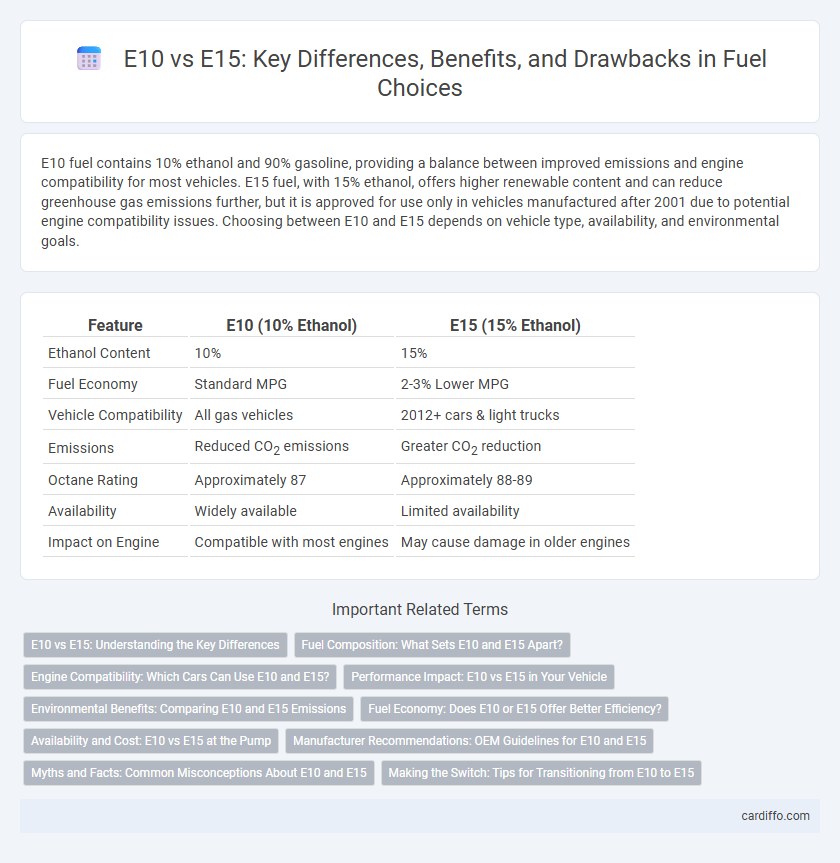E10 fuel contains 10% ethanol and 90% gasoline, providing a balance between improved emissions and engine compatibility for most vehicles. E15 fuel, with 15% ethanol, offers higher renewable content and can reduce greenhouse gas emissions further, but it is approved for use only in vehicles manufactured after 2001 due to potential engine compatibility issues. Choosing between E10 and E15 depends on vehicle type, availability, and environmental goals.
Table of Comparison
| Feature | E10 (10% Ethanol) | E15 (15% Ethanol) |
|---|---|---|
| Ethanol Content | 10% | 15% |
| Fuel Economy | Standard MPG | 2-3% Lower MPG |
| Vehicle Compatibility | All gas vehicles | 2012+ cars & light trucks |
| Emissions | Reduced CO2 emissions | Greater CO2 reduction |
| Octane Rating | Approximately 87 | Approximately 88-89 |
| Availability | Widely available | Limited availability |
| Impact on Engine | Compatible with most engines | May cause damage in older engines |
E10 vs E15: Understanding the Key Differences
E10 fuel contains 10% ethanol and 90% gasoline, while E15 consists of 15% ethanol and 85% gasoline, impacting fuel efficiency and engine compatibility. Vehicles with model year 2001 and newer are generally approved for E15 use, although some engines, like those in boats or small equipment, may experience damage or voided warranties. The higher ethanol content in E15 can offer slightly lower greenhouse gas emissions but may reduce miles per gallon compared to E10 due to ethanol's lower energy density.
Fuel Composition: What Sets E10 and E15 Apart?
E10 fuel contains 10% ethanol and 90% gasoline, while E15 fuel increases the ethanol content to 15%, impacting combustion properties and emissions. The higher ethanol concentration in E15 improves octane rating and reduces greenhouse gas emissions but may affect engine compatibility in certain vehicles. Understanding the precise fuel composition is crucial for optimizing performance and meeting environmental regulations.
Engine Compatibility: Which Cars Can Use E10 and E15?
E10 fuel, containing 10% ethanol, is widely compatible with nearly all gasoline-powered vehicles manufactured after 2001, including most conventional and hybrid cars. E15 fuel, with 15% ethanol, is approved for use only in model year 2001 and newer gasoline-powered cars, light trucks, and SUVs, but not in motorcycles, heavy-duty vehicles, or marine engines. Automakers like Ford, GM, and Toyota have validated that their vehicles from 2001 onward can safely use E15, though it is essential to check the owner's manual for specific compatibility to avoid potential engine performance issues.
Performance Impact: E10 vs E15 in Your Vehicle
E10 fuel contains 10% ethanol, offering a balance between performance and emissions, while E15 increases ethanol content to 15%, potentially enhancing octane levels but risking reduced fuel economy and engine efficiency in some vehicles. Vehicles specifically designed or approved for E15 can experience comparable or slightly improved performance due to higher octane ratings, yet legacy engines may encounter hesitation or decreased power output. Fuel economy tests reveal E10 generally provides better mileage, making it the safer option for most passenger cars without explicit E15 compatibility.
Environmental Benefits: Comparing E10 and E15 Emissions
E15 fuel contains 15% ethanol, reducing greenhouse gas emissions more effectively than E10 with its 10% ethanol blend, contributing to lower carbon monoxide and particulate matter levels. Studies show E15 can decrease tailpipe emissions of volatile organic compounds (VOCs) and nitrogen oxides (NOx), which are critical contributors to smog formation and respiratory issues. The higher ethanol content in E15 also enhances oxygenation, improving combustion efficiency and further lowering harmful emissions compared to E10.
Fuel Economy: Does E10 or E15 Offer Better Efficiency?
E10 typically provides slightly better fuel economy compared to E15 due to its lower ethanol content, which offers higher energy per gallon. E15 contains 15% ethanol, reducing the overall energy density and potentially decreasing miles per gallon by about 1-3% compared to E10. However, vehicle compatibility and engine design can influence the actual efficiency differences between these two fuel blends.
Availability and Cost: E10 vs E15 at the Pump
E10 fuel, containing 10% ethanol, is widely available at most gas stations and generally costs slightly less than pure gasoline due to ethanol subsidies. E15, with 15% ethanol, offers a higher renewable content but is less commonly available and often priced marginally lower than E10, reflecting its limited distribution and compatibility restrictions for vehicles. Consumers should verify vehicle compatibility and local availability since E15 is not approved for all engines, influencing the cost-effectiveness and access at the pump.
Manufacturer Recommendations: OEM Guidelines for E10 and E15
Most vehicle manufacturers recommend using E10 fuel, which contains up to 10% ethanol, as it aligns with OEM engine design and warranty requirements. E15 fuel, containing 15% ethanol, is generally approved only for newer model vehicles (typically 2001 and later) specifically listed by the Environmental Protection Agency and manufacturers. Ignoring OEM guidelines for E15 can lead to engine performance issues and may void manufacturer warranties.
Myths and Facts: Common Misconceptions About E10 and E15
E10 and E15 fuels differ mainly in ethanol content, with E10 containing 10% ethanol and E15 containing 15%, yet many myths suggest E15 damages all vehicle engines, which is false as most modern vehicles from 2001 onward are E15-compatible. Concerns about increased fuel consumption or damage to older engines are often overstated; research shows that E15 has similar or slightly improved emissions profiles compared to E10. Misconceptions also include the belief that E15 is unavailable or illegal, but E15 is approved by the EPA for use in many vehicles and is increasingly offered at U.S. fuel stations.
Making the Switch: Tips for Transitioning from E10 to E15
Switching from E10 to E15 fuel requires verifying vehicle compatibility, as older models may not support the higher ethanol content safely. Using fuel system cleaners can help prevent deposit buildup caused by increased ethanol concentration, ensuring smooth engine performance. Regularly monitoring fuel efficiency and engine response after the transition allows for timely adjustments to maintain optimal operation.
E10 vs E15 Infographic

 cardiffo.com
cardiffo.com